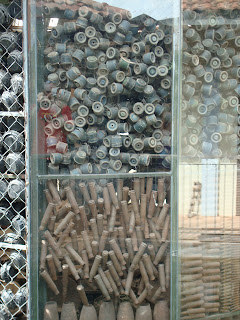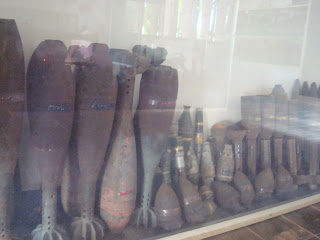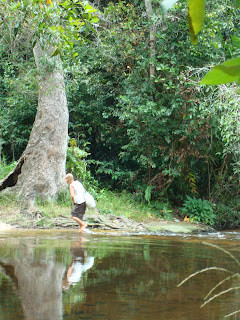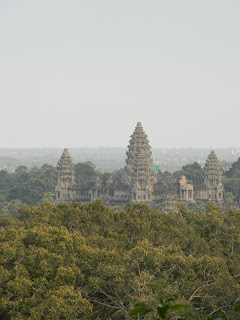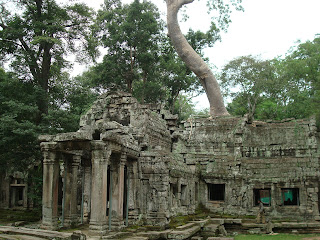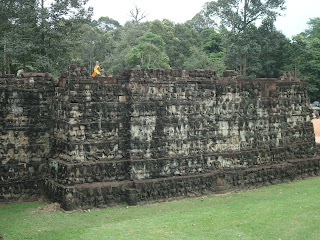Living in a predominately Buddhist community means there are Wats everywhere. A Wat is a Buddhist temple and Cambodia is filled with them. The temples, or Wats, are gorgeous and are built in a variety of styles and sizes. Since Siem Reap is the kick-off town for Angkor Archaeological Park we thought we should go and see what's there. We found a well-known loophole in the park rules that if you buy your ticket after 5 PM it is good for the next day, but that also means you can enter the park that day until it closes. This allowed us to see a sunset at Phnom Bakheng and a sunrise at Angkor Wat, both are quite beautiful. All said and done we easily spent somewhere between seven-eight hours in the park, my wife ran through two sets of batteries in her camera, and we collectively took just over 700 photos (that is without one camera for 1/3 of the time there). It was an amazing time - expressing how I feel about the experience is more daunting than I imagined on my Tuk Tuk ride home.
It was an enthralling evening and following morning walking around and literally through the ancient Hindu and Buddhist temples. Mainly constructed between the 9th-12th Centuries during the reign of the Khmer empire, these magnificent sandstone structures are simply gorgeous. All are under construction to a certain extent, limiting some of your opportunities to see various parts of the temples, but there is still a plethora of images to occupy yourself. Since the temples are at least 800 years old and situated in a tropical jungle, it is understandable that they are in disrepair. There are braces holding up many sections of walls, hallway pillars and even staircases. Many times you will see a group of stones on the ground with white numbers and letters written on them. These numbers and letters correspond with the temple and the exact location of that stone for the reconstruction of the according temple. Rebuilding all of the temple in the park is a literal lifetime job. Since the restoration began in the 1960s, other than a pause during the reign of the Khmer Rouge, these temples have been under some level of rehab. The pictures below do not provide any justice for what we saw.
Phnom Bakheng - This temple, built at the end of the 9th Century and dedicated to the Hindu god Shiva, is at the top of a tall hill. It took us about ten minutes to hike to the top on a well trodden path. Along the trail we saw other temples, rice paddies and Angkor Wat off in the distance.
you can see how the buildings are literally crumbling
all that remains of a structure on the site
the peaks and a dog
as the sun is setting
a small structure full of Buddha statues
a structure we saw while hiking
you can ride elephants
rice paddies we saw while hiking
Angkor Wat in the distance as we were hiking
Angkor Wat - This site is considered the crown jewel of the entire park. Constructed in the early 12th. Century and dedicated to Vishnu, it is huge and full of very detailed Bas-reliefs. Angkor Wat means to "City of Temples" in Khmer, which makes sense as this temple site is over five-hundred acres and surrounded by a moat. I cannot imagine what is temple looked like when it was new, it must have been a spectacular site.
as the sun is rising
sunrise
the sunrise reflected in a pond
this looked like a swimming pool
a view inside
interior hallway
a carving on a post
a shrine
a monk tying a bracelet for luck on my wife's wrist
a row of Hindu statues
a Buddha statue with a gold sash
a doorway
the sun reflecting on Angkor Wat
an exterior wall
notice the wooden stairs - the stone stairs are very steep
not realizing I was walking through the frame
a detail of the exterior relief carvings
inside the temple
on the left is a staircase
notice the staining on the figure on the left, it is a challenge to keep the temple clean - these figures are know as devatas and are found all over the temple
an inscription on a post, likely a prayer
a view from road leading out the back
this was once a library
a small temple at the back of the Angkor Wat site - I don't know the name
the moss and shadows made this feel ominous
the crumbling wall
Ta Prohm - In the battle of man vs. nature, nature won. This Buddhist temple, built in the mid 12th Century, has been taken over by the trees. After the temple was abandoned in the 15th Century, it was neglected until the early 20th Century when restoration began. It is quite the eerie site to see trees growing through and over several buildings and walls. There are two types of trees growing here, I was told silk-cotton and gold apple - apparently this is debated.
the gate through which we entered
the trees took over
to give you some perspective, I'm 5'10" and 155lb.
a tree growing out of a building
a closeup of a carving
a tree growing up the corner of a building
a tree growing over a wall
the side view of the tree above
a tree inside a building
a building that is crumbling
a tree grew around a window
an exterior hallway
a tree growing on top of a building
a tree consuming a wall
the inside of the structure
an entrance with a tree
a small structure on the site
a sign illustrating the reconstruction of the site
the final rebuild of the picture above
trees and buildings
some serious roots
interior courtyard
a former hallway
closeup of a carving
more carvings
Victory Gate - One of many amazing gates in the park to enter Angkor Thom.
Ta Keo - Reddish in color, this is a temple with a very steep staircase. Built in the year 1000, it is in a serious state of disrepair and is currently under construction. It was built to resemble a mountain and once inside you see a seriously steep staircase reminiscent of a mountainside.
the temple from outside
the steep interior staircase
looking down the stairs my wife bravely climbed in the rain
a view from the top
small building at the top
looking down - if you look closely, you'll see me in a doorway
a view of the exterior wall from the top
the interior of the temple
interior view of the entrance
an exterior view of the temple
Thommanon - A small Hindu temple built in the 1100s is in very good condition because of a complete restoration in the 1960s.
an exterior view
a doorway with plant growing through the stones
some of the carvings
the back of the temple
on of the small structures on the site
a small shrine
more carvings
Chau Say Tevoda - A very small Hindu temple constructed in the mid-12th Century and was restored from 2000-2009.
This is where we received our second red bracelet for luck of the day. We saw a woman with a shaved head praying in a small room of the temple. After her prayer ended, she approached us with incense to place at the shrine. She looked very sad and after we placed the incense, she wrapped a bracelet on each of our wrists. A woman with a shaved head usually signifies the loss of a child. It was a very gripping experience, one I'll never forget because it incorporated nearly every sense - the sight of the woman and the temple, the sound of her voice while praying and then guiding us to the shrine, the smell of the incense, and the feel of walking across the stones and sticking the incense in the sand-filled vase. For how brief our encounter, it is an indelible experience.
multiple structures on the site
some of the rehab work
a closer detail of the rehab
a small structure
the woman who placed a second red bracelet on our wrists
exterior of the structures
another exterior shot
Angkor Tom - The last capital city of the Khmer empire, this site has several temples in one relatively dense location. Constructed in the late 12th Century, this remained the capital until the early 17th Century. Originally surrounded by a moat eight miles in circumference, Bayon is the centerpiece of this site, as are the entrance gates. It was a very peaceful site to walk around and even climb to the top of a tiny but tall temple.
some structures just outside the walls
crumbling structure outside the walls
multiple structures outside the main wall
a new dog
an old dog
Terrace of the Elephants
Terrace of the Elephants
a carved exterior wall
Buddha's carved into the wall
more Buddha's carved into the wall
a detail of the Buddha carvings
another view of the exterior wall
an outdoor shrine
a doorway
approaching a small gate through the wall
a crumbling structure
stairs up the crumbling structure
more of the same structure
the staircase to climb to the top of the same structure
some ruins on the site
more ruins on the site
the gate through which we exited
Bayon -
Simply an amazing Biddhist temple in Angkor Thom. The serene faces carved in stone are beyond words and resemble Jayavarman VII, the king at that time. I wish Mr. Peabody would show up and take me back the the late 12th C. when it was built to see what this originally looked like.
a tall and very detailed temple
you can start to make out the faces carved in the pillars
a former hallway leading to the highest point
a carving on a post
a former hallway
looking up at the stone faces
a hallway inside the temple
a stone face
you can see how the faces are carved on all four sides
two profiles
several faces carved in the temple
young Apsara dancers
looking down into the temple
looking up at the highest point
leaving the temple
Ba Puon - Built in the mid-11th Century, the bridge entrance still makes a strong impression. This temple, under restoration since the 1960s, was just recently completed. I would assume when the rains come and the pools fill, this site is even more beautiful.
a small pool of water with the stone bridge
a view from the pool of water
the rather sizable temple
the bridge
a view from the end of the bridge
the pool of water
a view from the bridge
another pool of water in from of the temple
a shrine
South Gate - Another of the gorgeous gates in the park.
a great image to see when exiting the Angkor Tom site
This was an amazing experience. The amount of detail that remains only increases my curiosity of what it looked like when it was originally constructed. I am no expert on architecture, but the scale and density of the park blew my mind. It is not that I've seen a lot of amazing architecture in person, but this was just otherworldly - it is so different from what I've seen through my travels in America or in Europe. In the a thirty mile area, there are seventy-two major temples and several hundred minor temples. Temples are still unearthed with frequency with the aide of satellite digital imaging.
How were these temples created? Where/when were the stones carved? When you are there, you cannot help but ask yourself these questions. After some research to write this post I learned that the stones were originally as smooth as polished marble and the joints were hard to find. The stones were moved by elephants, ropes, pulleys and bamboo scaffolding. They are made from sandstone quarried twenty-five miles away and were likely transported via raft. Experts claim that it would take over three-hundred years to build Angkor Wat today, but it took them just over forty years in the 12th Century. There were approximately one-million people living in the area at that time, many more than there are in present day Siem Reap. The sheer number of people living in the area, in addition to the lack of organizations like OSHA, would make construction on this scale possible. To blink and see these temples in the year 1200 would be something to behold.
*All of my info is from either National Geographic Traveler or wikipedia.
 At this museum, you are educated on how devastating landmines are and specifically how much havoc they have wreaked on the Cambodian people. There are multiple rooms located around a central lilly pad pond, each room dedicated to a different aspect of landmines and their removal in Cambodia. You see so many defused landmines and bombs used in the infamous carpet-bombings of the countryside, it is something you will not forget. There is also a display showing what the different Cambodian and Vietnamese soldiers wore and the guns, grenade launchers, and various other weapons used while fighting - the uniforms and weapons were all found in former camps by Aki Ra and other people in the organization. While at the museum, we met an American man working for the organization who provided a ton of interesting information about the organization and what they do. We were there for what came to be an insightful hour on the way to Phnom Kulen National Park. (little did I know at the time, but the man at the museum goes to the same pub quiz I do, it is the only pub quiz in town - there is a very small expat community here)
At this museum, you are educated on how devastating landmines are and specifically how much havoc they have wreaked on the Cambodian people. There are multiple rooms located around a central lilly pad pond, each room dedicated to a different aspect of landmines and their removal in Cambodia. You see so many defused landmines and bombs used in the infamous carpet-bombings of the countryside, it is something you will not forget. There is also a display showing what the different Cambodian and Vietnamese soldiers wore and the guns, grenade launchers, and various other weapons used while fighting - the uniforms and weapons were all found in former camps by Aki Ra and other people in the organization. While at the museum, we met an American man working for the organization who provided a ton of interesting information about the organization and what they do. We were there for what came to be an insightful hour on the way to Phnom Kulen National Park. (little did I know at the time, but the man at the museum goes to the same pub quiz I do, it is the only pub quiz in town - there is a very small expat community here)





